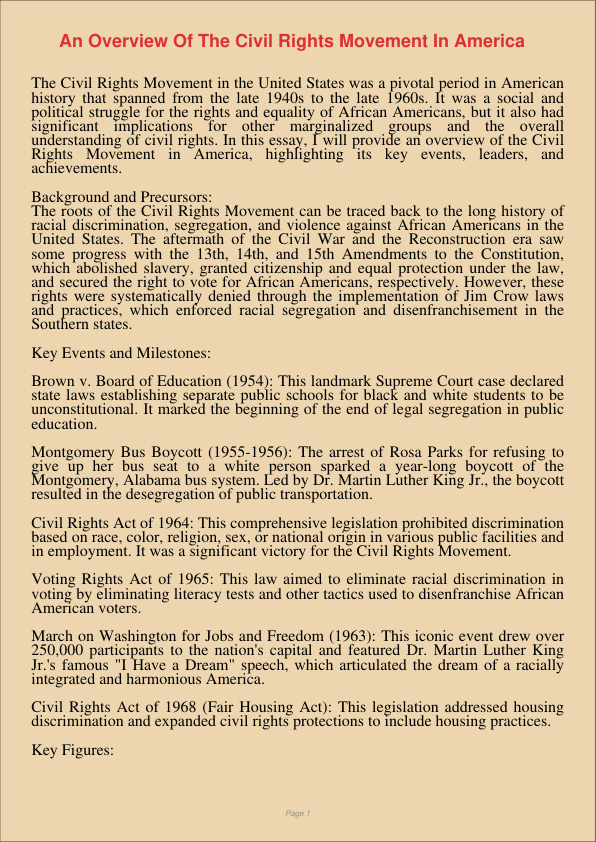An Overview Of The Civil Rights Movement In America
Jan 12, 2024
civil rights movement
overview
Psychology
Philosophy
The Civil Rights Movement in the United States was a pivotal period in American history that spanned from the late 1940s to the late 1960s. It was a social and political struggle for the rights and equality of African Americans, but it also had significant implications for other marginalized groups and the overall understanding of civil rights. In this essay, I will provide an overview of the Civil Rights Movement in America, highlighting its key events, leaders, and achievements.
Background and Precursors: The roots of the Civil Rights Movement can be traced back to the long history of racial discrimination, segregation, and violence against African Americans in the United States. The aftermath of the Civil War and the Reconstruction era saw some progress with the 13th, 14th, and 15th Amendments to the Constitution, which abolished slavery, granted citizenship and equal protection under the law, and secured the right to vote for African Americans, respectively. However, these rights were systematically denied through the implementation of Jim Crow laws and practices, which enforced racial segregation and disenfranchisement in the Southern states.
Key Events and Milestones:
Brown v. Board of Education (1954): This landmark Supreme Court case declared state laws establishing separate public schools for black and white students to be unconstitutional. It marked the beginning of the end of legal segregation in public education.
Montgomery Bus Boycott (1955-1956): The arrest of Rosa Parks for refusing to give up her bus seat to a white person sparked a year-long boycott of the Montgomery, Alabama bus system. Led by Dr. Martin Luther King Jr., the boycott resulted in the desegregation of public transportation.
Civil Rights Act of 1964: This comprehensive legislation prohibited discrimination based on race, color, religion, sex, or national origin in various public facilities and in employment. It was a significant victory for the Civil Rights Movement.
Voting Rights Act of 1965: This law aimed to eliminate racial discrimination in voting by eliminating literacy tests and other tactics used to disenfranchise African American voters.
March on Washington for Jobs and Freedom (1963): This iconic event drew over 250,000 participants to the nation’s capital and featured Dr. Martin Luther King Jr.’s famous “I Have a Dream” speech, which articulated the dream of a racially integrated and harmonious America.
Civil Rights Act of 1968 (Fair Housing Act): This legislation addressed housing discrimination and expanded civil rights protections to include housing practices.
Key Figures:
Dr. Martin Luther King Jr.: A central figure in the movement, he advocated for nonviolent civil disobedience and played a key role in organizing protests and advocating for civil rights legislation.
Rosa Parks: Often called the “mother of the civil rights movement,” her refusal to give up her bus seat sparked the Montgomery Bus Boycott.
Malcolm X: An influential leader who advocated for a more confrontational approach to civil rights and racial equality, he later became an advocate for a more inclusive and human rights-based approach.
Thurgood Marshall: As an attorney, he successfully argued the Brown v. Board of Education case before the Supreme Court and later became the first African American Supreme Court Justice.
Achievements and Legacy: The Civil Rights Movement achieved several key milestones, including the dismantling of legal segregation, the securing of voting rights, and the passage of significant civil rights legislation. Its legacy includes greater social and political awareness of the need for equal rights, the inspiration for subsequent movements for the rights of other marginalized groups, and the continuing struggle for racial justice and equality in the United States.
In summary, the Civil Rights Movement in America was a transformative period characterized by the tireless efforts of activists and leaders who fought for racial equality and civil rights. It had a profound impact on the nation’s legal and social landscape, shaping the ongoing struggle for justice and civil rights in the United States.
